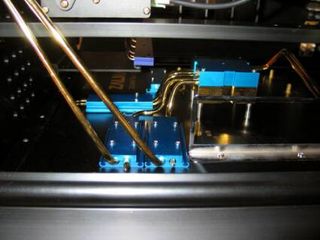Noiseless Computing: New Case Innovation From Zalman
Totally No Noise Computing With The TNN 500A, Continued
| Specifications For The TNN 500A | |
|---|---|
| Number Of Internal 3.5" Bays | 4 |
| Number Of External 3.5" Bays | 1 |
| Number Of External 5.25" Bays | 2 |
| Number Of Case Fans Supported | None - TNN 500A uses an innovative convection cooling systems to move heat to the outside of the case. |
| Construction Material | Aluminum from 5mm to 7mm thickness |
| Power Supply Details | 300 Watt - No Fan PSU included |
| Special Features | No Fan Design, 2 Front Mounted USB 2.0 ports behind front door |
| Size | 22.5("H") x 11.25("W") x 15.75("D") |
| Sample Case Provided By | www.zalman.co.kr |
| Estimated Cost | Less Than $1400.00 US - Final Pricing Not Set |
| Cooling Potential Rating | 8 |
| Construction Quality Rating | 9 |
| Overall Case Rating | 8 |
The philosophy behind this cooling approach is simple: Zalman employs cooling blocks/heatsinks that are connected to heat pipes; these pipes move the heat from the inside of the case to the outside of the chassis's heat sink panels using contact blocks attached to the inside panels of the chassis. For example, the CPU Heatsink inside the TNN 500A uses six 6mm heat pipes to move the heat from the CPU to the outside of the chassis for heat dissipation. Zalman claims that in the CPU cooler, for example, using the six 6 mm heat pipes can combine effectively 100 Watts of heat, affording ample cooling for the hottest CPUs. By way of comparison, the heat transfer rate of an Intel 3.06 GHz chip is about 83 Watts. Following Zalman's principles of heat dissipation, this should provide for ample cooling without problems.

A closer look at how the heat pipes attach to the case.
In addition to the CPU heat pipe cooling methodology, Zalman also offers a heat pipe cooling transfer system using two 6 mm heat pipes that should provide ample cooling for the highest performance video cards. These two heat pipes for the VGA cooler combine 50 Watts cooling capable of handling the hottest GPUs. Besides the VGA and CPU heat pipe coolers, Zalman introduces and provides a no-fan power supply that also utilizes a heat source contact method developed by Zalman for power supply heat dissipation to the outside of the chassis.
Stay on the Cutting Edge
Join the experts who read Tom's Hardware for the inside track on enthusiast PC tech news — and have for over 25 years. We'll send breaking news and in-depth reviews of CPUs, GPUs, AI, maker hardware and more straight to your inbox.
Current page: Totally No Noise Computing With The TNN 500A, Continued
Prev Page Introduction Next Page Totally No Noise Computing With The TNN 500A, ContinuedMost Popular

